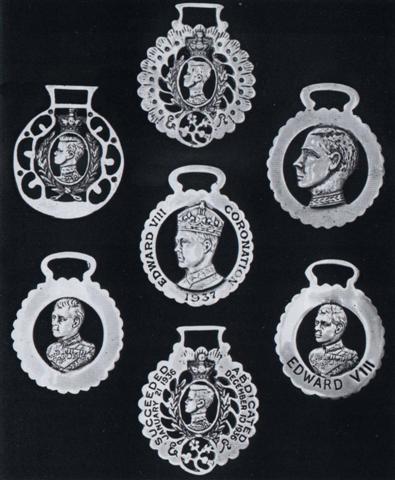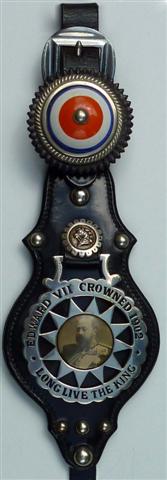Royalty Brasses
R.J. Bradshaw.
During the Horse Brass era many different types of brasses adorned the decorated harness and ranking high amongst those most sought-after by modern collectors, are ones that are refered to as "Royalty" brasses. These brasses were usually manufactured the year before in readiness to commemorate the particular event that they depict, so in fact, it is probably fair to say that no other type of brass can be dated quite so precisely. So popular is this avenue of horse brass collecting that it has been covered twice by specialist publications from the NHBS since its formation in 1976. Details of the most recent publication, Royalty Brasses can be seen on the link entitled, Trade Items, and is an excellent volume for the beginner or indeed the veteran collector with photographs of close to three-hundred types.
The first royalty brasses are still a matter for contention as is the early beginnings of horse brasses themselves. Some argue that those brasses that feature the younger or "bun" head of Queen Victoria actually date back to her coronation in 1837 but to date, no proof positive has ever surfaced to support this theory. Due to the untimely death of her beloved Prince Albert in in 1861, no brasses (arguably) were produced to celebrate her Silver Jubilee in 1862, but by the time of her Golden Jubilee in 1887, the Bristol, Birmingham and Walsall manufacturers were ready to take on the challenge of producing a range of brasses to help horsemen celebrate the event.
Below; Three early "Bun" head types taken from the first NHBS publication, Royalty Brasses. The head is not actually the famous, Wyon "bun" head as used on the coinage but a very close approximation of it. Though there are some that argue that these brasses date from the coronation in 1837, they are far more likely to have been produced in 1861-2 for the Silver Jubilee celebrations, which never took place and are also thought by some to have originated the term "Face-Piece" used for all hanging brasses in later years.
The 1887-1897 Jubilee.
By the time of the later Victorian Jubilees the Queen had emerged from her prolonged period of mourning to a nation ready to celebrate, and the Walsall manufacturers rose admirably to meet the challenge of producing the many different designs we see in collections today. No-one knows for sure just how many different royalty commemoratives there are as a few, previously unrecorded types, still surface today. Illustrated below however, are just three Jubilee types that typify the period.
Edward VII. 1902-1911
After the death of Queen Victoria in January 1901, a new series of brasses were made to celebrate the Coronation of Edward VII in 1902, which saw some marvellous examples from most of the large factories (see Walsall and Birmingham pattern books page) which include some of the patterns seen in the panel below.

Left; A small representative selection of brasses both cast and stamped, made for the coronation of Edward VII in 1902. The red, white and blue china centres are also typical of this period and were often worn with worsted rosettes or ribbon backing to achieve a more colourful display.
The matching pair of straps are loin or kidney straps and compliment this small collection very well indeed. The hame-plate (bottom) is also typical of the period as is the splendid swinger, and face-piece in the middle and top centre of this panel.
Many collectors often note the excellent condition of the royalty brasses in their collections, which is probably no accident. Some were no doubt bought by other folk (apart from those who had horses) as souvenirs and even the heavy horse community probably only used these decorations only a few times that year before their careful wrapping and storage, which is how the kidney straps were found In farm buildings in Derbyshire.
George V. 1911-1936.
Following the death of Edward VII came the Coronation of George V, in 1911 which gave us another fabulous crop of brasses a small selection of which are seen below. Some collectors often note how brasses from this period are less common perhaps? and this has been ascribed to the fact that, by 1911, horse power in the major towns and cites was in already in decline, yet there can be little doubt that some of the brasses produced during this era were extremely innovative, and some of the best ever seen.
Above; four representative types made for the coronation of George V in 1911. The two face-pieces are also seen in the border, and a splendid George V martingale can be seen in the section below..
Edward VIII 1936 & George VI 1937-1952
After the death of George V in 1936, the heavy horse had indeed witnessed a serious decline but despite this, a series of brasses were made to commemorate the coronation of Edward VIII, which indicates, once again, how such things were made in readiness even though the event never took place, as is depicted by this panel of brasses taken from Collecting Royalty Brasses (2001) page 37.

Left a series of brasses made to commemorate the coronation of Edward VII that never took place, one of which was later modified to commemorate the abdication itself. when these brasses are encountered it is often noted how hardly any display harness wear but there are exceptions. Below, three brasses made to commemorate the Coronation of George VI in 1937, of which the same could be said, which are also taken from the same publication as the panel on the left.
Elizabeth II 1953-Present
The Coronation of Elzabeth II in 1953 saw the usual crop of brasses many of poor design and finish, but these were mainly made for the souvenir trade and not horse wear. By the Elizabethan Era the use of heavy horses had almost died out but in some of the larger cities for instance, some short haulage work was still done by horses, and the carters wishing to celebrate the Coronation were duly provided for.
Below; a fine study of the Birkenhead Coronation Horse Parade in 1953, which portrays, well enough, just how many horses were still employed in Liverpool in the early fifties. Note the coal drey in the foreground which was the entry from Houldins Coal whose hoarding exhorts that, " Houldins Coal is Grate Stuff."

Below; the Coronation of Elizabeth II and following celebrations has seen another crop of comemmorative brasses from 1953 onward with the last pair being made fifty years later by our own KB Brasses to commemorate the Golden Jubilee in 1992. The first pair are as good as any royalty types made for the coronations in 1902, 1911 and 1937, but these are the exceptions as most from this time could only be considered, "gift shop" or souvenir types. Exactly the same can be said of the second pair which, though they were made 50 years later, are of similar high quality, and may well have been used by moden showmen on heavy horses. A very high standard has also been seen in the stamped brasses of the period 1977-2002 which used a variety of coloured, ceramic centres to add to the overall effect, and an excellent selection of these can be seen on the Stamped Brasses link, along with other stamped Royalty types. Further types over progressive years have seen an Elizabeth II "Record Reign" type, as well as the Sapphire Jubilee type also produced by the N.H.B.S in 2017 (see sales pages).


Below; A fine, mixed Royalty collection that has been made by one member over recent years. Some are very rare whilst others may come more easily to hand perhaps. This board aptly shows just what sort of collection can be achieved with care, patience, and dilligent search, and how, when mounted thus, what a fabulous effect can be achieved. from such a display.
Martingales
Aside from the matching pair of loin, or kidney straps shown in the Edward VII panel above, other types of strapping or even a martingale are sometimes encountered though these are becoming highly sought after and are very rare. Genuine examples of these (for some have certainly been made up in recent years) were obviously made on the orders of some prosperous individual especially for a Coronation parade and many were never worn again.
Below; three spendid examples of royalty martingales with far left, a predominantly 1887 Jubilee theme,and centre and right two a rare George V types with the one on the far right having two photographic centre types in very good condition, which in itself is a rarity, as these have often suffered badly over the years.
Although martingales like these are very rare nowadays, though collectors should not be put off as several of the pieces illustrated were found in local antique salerooms or at the ubiquitous car boot sales that occur evey weekend up and down the country, so try your luck, because you never know what you may find.
Photographic Centres.

As we can see in the splendid George V martingale above, an innovation of the 1902 and 1911 Coronations was of course the well-known photographic centre types which are extremely popular with collectors and highly sought after. As can be seen on the martingale above, and the further examples below, some have survived in pristine condition which, as already stated, is a rarity in itself.
Left; A rare Scottish, single brass martingale displaying a pristine example of a photographic centre, and below right, two fly-terrets or "swingers" also with photographic centres, both in excellent condition. The fact that some have not suvived very well is largely due to the use of early semi-synthetic plastics such as cellulose nitrate or cellulose acetate being used for the clear film which covered the photograph itself. This can often react badly with tin, which of course the pictures are mounted on, and under adverse conditions, this causes this volatile medium to degrade further. This occurs because, if left to their own devices, both mediums attempt to return to their earlier forms i.e. cellulose and its plasticiser, which is either nitric or acetic acid. When this happens, a breakdown known as chain-scission occurs which can often be seen as a surface that has become cracked or crazed. This can often lead to further degradation as the cellulose breaks down further to leave a characteristic brownish, acid staining on the photograph. If these are to be collected, a low UV light storage is advised with a carefully chosen place that will allow for low-humidity levels, and good air circulation, which should ensure that these spendid examples should survive long into the future. Luckily, these centres can still be found as pin-back badges, which may adapt themselves very well as replacements for lost or badly damaged examples.


Collectors nowadays wonder which will be the next big Royal celebration? At the time of writing, our Queen has already surpassed Queen Victoria's "Record Reign" and is celebrating her Sapphire Jubilee. Meantime, we hope that this page has proved interesting and informative for members and readers. As can be seen in the representative selection here, collecting Royalty brasses can be a very rewarding pastime, which given patience and care, can be built up into a very nice collection to be enjoyed for years to come.